Top News
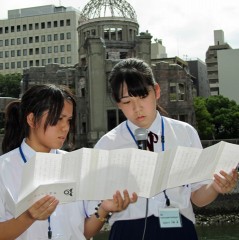
August 7, 2011 Eriko Tamaki of Ryukyu Shimpo
Second-year students 16-year-old Rei Yohena and Haruka Ohashi of Chatan High School attended a memorial ceremony in Hiroshima on August 6 to mark the 66th anniversary of the atomic bombing of the city.
Both students belong to the Chatan Town Hiroshima Peace Study Delegation.
At a memorial ceremony hosted by Hiroshima Atomic Bomb Survivors Relief Association, the students followed the traditional dedication of water, which symbolizes the water the victims of the atomic bomb desperately needed but could not find that day, with the offering of a floral tribute.
The students delivered their messages of peace, saying, “We would like to learn about past wars and the atomic bomb, and hope that the preciousness of peace and the value of life will be passed on with a pledge to consolidate peace.”
In their messages, they made reference to the Battle of Okinawa, in which many local civilians were either killed or compelled to engage in “group suicide” (shuudan jiketsu), and the fact that the atomic bomb killed tens of thousands of people in Hiroshima, with survivors suffering permanent physical damage and psychological trauma. The students said, “Those before us lost so much because of the war.”
Referring to the crisis at the Fukushima Nuclear Power Plant, they said, “With 66 years having passed since the United States dropped the atomic bomb on Hiroshima, it seems that whatever nuclear power is used for, be it for peaceful or military purposes, it could lead to life-threatening situations if mistakenly used.”
They strongly wished for a peaceful future, saying, “From this day forward, we would like to live our lives in a peaceful and hopeful world. We would like our children and grandchildren to live their lives in a world full of hope.”
(English Translation by T&CT, Mark Ealey)
Go To Japanese
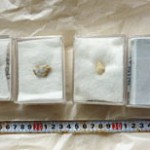
August 5, 2011 Ryukyu Shimpo
The staff of the Okinawa Prefectural Museum & Art Museum held a press conference at the excavation site in Sakitari Cave, Tamagusuku, Nanjo City, on August 4, announcing that they have unearthed three fragments of quartz and one piece of human bone (tooth).
The excavation team, which aims to discover links to the Minatogawa Man, who existed about 18000 years ago, has worked at the Sakitari Cave, in the “Valley of Gangara” next to Okinawa World.
The human bone and quartz were discovered between the covering layers of the earth of 4500 years ago and the black layers about 20 centimeters below that, which includes carbon-rich strata estimated by radiocarbon dating to be approximately 19000 years old. Therefore the bone is speculated as being from the period between 4500 and 19000 years ago, but the specific era has not yet been identified.
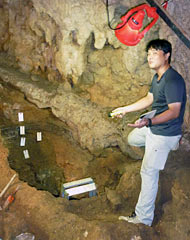
On August 4, at the Gangara Valley, Nanjo City, Shinji Yamasaki, who is responsible for the excavations, explains the work in front of a geological formation dating back 19000 years.
Quartz rock is not naturally found in the southern areas of Okinawa’s main island, so it is presumed that it was brought there by human beings. Sakitari Cave is located about one kilometer away from the Minatogawa Fissure archaeological site where the Minatogawa Man was found, and the river, which leads to the site. The team has been working hard on its investigation.
The layers dating back 19000 years include a larger amount of crab claws and snail shells than other layers. Shinji Yamasaki, who is in charge of the excavation said, “We are not sure whether someone built a fire here or if it was a fire that just occurred naturally, but there is some unusual strata there. Something definitely happened there. If we continue our investigation we may be able to discover some evidence of the Minatogawa Man of 18000 years ago.”
The excavation will continue to August 7, and will be open to the public on August 6 and 7.
Phone calls requesting information should be directed to Okinawa World Culture Kingdom: 098 949 7421.
(English Translation by T&CT, Mark Ealey)
Go To Japanese
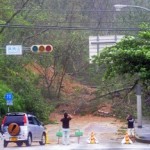
August 7, 2011 Ryukyu Shimpo
As of 10:00pm on August 6, Typhoon No. 9 is out over the East China Sea, heading north-northwest away from the Okinawa region at 15 kilometers per hour. It left the main island of Okinawa shortly after noon yesterday and Kumejima just after at 1:00pm the same day, thereby releasing them from the area experiencing 25-meter per second winds. From the afternoon of August 4, the main island region was battered by the typhoon for almost 46 hours. According to regional fire departments and the Disaster and Crisis Management Division of the Okinawa Prefectural Government, 51 people suffered either minor or serious injuries, and as of 11:00pm on August 6, power to about 99000 households had been cut. The power outage for about 17000 households still continued as of midnight August 7.
A mudslide occurred along the prefectural road No. 72 in Gogayama, Nakijin Village, at about 12:20am on August 6 with part of the mountain surface about 30 meters high and over 20 meters wide collapsing to block the road. Keiko Iha, a 92 year-old woman who took refuge in the community center, said, “I was scared that the mud slide was getting close to my house.”
The northern area of the main island experienced record levels of torrential rain. In the Jahana district, the total amount of rainfall during the period from 11:00am August 3 to 11:00pm August 6 exceeded about 700mm, the equivalent of one-third of the total annual rainfall. In Miyazato, Nago City, Taira, Higashi Village and other areas, the deluge surpassed the previously observed record rainfall for a 24-hour period.
As of 6:00pm on August 6, telephone and Internet connection difficulties were reported for 1500 users in the prefecture. The NTT West Okinawa branch speculates that the number of failures will exceed 10000. The Okinawa branch has deployed 250 people, including the members from other branches of Kyushu areas, working on recovery support, on and after August 7.
This is the second time that the main island of the Okinawa region has been caught up in the storm band of a typhoon for more than 40 hours. The first occasion was with Typhoon No. 16, in September 2001, when there were 53 hours of storm conditions.
(English Translation by T&CT, Mark Ealey)
Go To Japanese

Go To Video
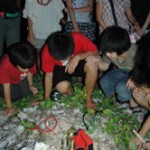
August 4, 2011 Yoshiya Hokama of Ryukyu Shimpo
At around 9:00pm on July 28, between 20 and 30 loggerhead turtles were identified as having hatched near the seashore at Ogimi Village. Turtle eggs had been deposited in the grassy area near the shore, and because many of the hatched baby turtles had become entangled in vines and were struggling to get to the sea Kunio Komesu, a member of Japan Sea Turtle Association, and local children, helped to get the hatched turtles to the sea.
Children from Nishi Aizu Town, in Fukushima Prefecture who were staying at Ogimi Village also watched the hatching and helped to move the baby turtles to the sea. The children from Fukushima and the local boys and girls shouted with joy as they watched the baby turtles going into the sea.
Towa Hasegawa, sixth grade pupil of Onomoto Elementary School, Nishi Aizu Town, was excited to say, “The little turtles have been coming out their eggs by themselves. It was great to see the turtles going back towards the sea by themselves. It was a new experience for me and so it was a lot fun.”
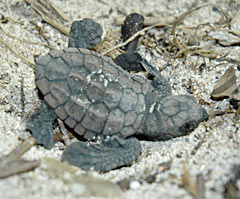
Baby turtles hatched in the sand at the seaside of Ogimi Village, July 28.
Komesu said that baby turtles are sensitive to light. On their way towards the sea they will sometimes change course and move in the direction of the national highway when exposed to the light from a street lamp, so some will die before reaching the sea.”
(English Translation by T&CT, Mark Ealey)
Go To Japanese
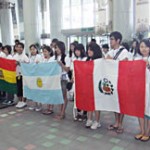
August 4, 2011 Ryukyu Shimpo
At the prefectural government office on August 3, a welcome ceremony was held for the participants of the Okinawa Junior Study Tour, in which a group of children of Okinawan who emigrated overseas learned about the history and culture of Okinawa.
Twenty-three participants from 16 Okinawa Kenjinkai (associations of people from Okinawa) in ten different countries visited Okinawa on August 2. They are scheduled to mix with high school and junior high school students from the prefecture and to deepen exchange over a period of seven days.
In the ceremony, Vice Governor Yoshiyuki Uehara praised the participants, saying, “I would like all of you to be proud of your forebears who left Okinawa to go to countries all over the world, doing well to establish themselves wherever they went.”
Sixteen-year-old Carolina Miyagi, a fourth-generation Okinawan-Brazilian, spoke on behalf of the group, saying, “We would like to acquire new treasures from Okinawa and to pass them on to the young generation of Uchinanchu all over the world, helping to promote the heritage of Okinawa.”
Third-year student 17-year-old Kouhei Iriyonekura of Urasoe High School, who represented the participants from within the prefecture, said, “I hope to become an internationally-minded person, who loves our local culture.”
The Okinawa Junior Study Tour is a project held in conjunction with the 5th Worldwide Uchinanchu Festival scheduled to be held in October.
The participants learn about the history, culture and natural environment of Okinawa, taking a course in Eisa and visiting Shuri Castle and the Okinawa Prefectural Peace Memorial Museum.
(English Translation by T&CT, Mark Ealey)
Go To Japanese
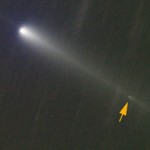
August 3, 2011 Ryukyu Shimpo
On August 2, Ishigakijima Astronomical Observatory announced that it has discovered a new comet in the dust trail of Comet 213P Van Ness, and that it has succeeded in taking a photograph of it in which the new comet resembles a child following along behind its parent.
Two staff of the observatory, research scholar Hidekazu Hanayama, and research engineer, Hideo Fukushima, photographed the new comet at 2:29am on July 30 and reported its presence to the International Astronomical Union the next day, July 31.
The new comet is considered to be small and to be made up of ice debris from Comet 213P Van Ness.
The current brightness of Comet 213P Van Ness is of the 13th magnitude and that of the new comet is of the 20th magnitude. Neither of the comets can be observed with the naked eye.
The observatory is now trying to calculate when the new comet was born and how fast it moved away from Comet 213P Van Ness.
Ishigakijima Astronomical Observatory began to observe Comet 213P Van Ness in the middle of July because Comet 213P Van Ness that orbits around Mars on an ellipsoidal trail reaches the opposite side of the Sun at the beginning of September, from which time it will become easier to observe.
(English Translation by T&CT, Mark Ealey)
Go To Japanese
August 3, 2011 Ryukyu Shimpo
The government has approved the White Paper on Defense 2011 edition at its Cabinet meeting on August 2. In its opening feature article, the White Paper mentioned the rescue operations for the affected areas in the Great East Japan Earthquake by Japan’s Self Defense Forces (JSDF) and “Operation Tomodachi” by the U.S. Forces in Japan. The paper is wary of a change in the security environment surrounding Japan, citing the example of Chinese military vessels having passed between Miyako Island and Okinawa in June.
With regard to the U.S. Marine Corps Air Station (USMCAS) Futenma relocation issue, it reports that at the US-Japan Security Consultative Committee (2+2) held in June, both governments confirmed the construction of a V-shaped runway off Henoko in Nago. The paper explains the reason for rejecting local demands that the facilities currently at Futenma be moved outside of the prefecture by stating, “There is a concern that moving [the USMCAS Futenma outside of Okinawa] would impair the function of the Marine Corps, so both governments came to the conclusion that the alternative facilities for Futenma will be constructed within the prefecture.”
On the matter of U.S. bases in Okinawa, it mentions that 74% of U.S. military facilities in Japan are concentrated in Okinawa. “In the context of the current international security situation [the government] needs to tackle the Okinawa base issue firmly to reduce the burden as much as possible,” the paper said.
“[The scale of the return program for bases located in areas south of Kadena] is currently being discussed with the United States.” With regard to whether or not this will be realized, it stated, “it will be possible to return these bases following the relocation to Guam and the relocation and return of the Futenma Air Station,” suggesting that USMCAS Futenma’s relocation within Okinawa and to Guam is condition for the return of bases located in areas south of Kadena.
With regard to the plan to move a portion of the Marine Corps personnel to Guam, it says, “Progress on the Realignment of U.S. Forces is very important in terms of reducing the burden on Okinawa.”
The White Paper stated that since fiscal 2009 the government of Japan has transferred funds to the U.S. side as direct budgetary support.
It does not mention that the United States is facing financial difficulties and has reduced its budget allocation for the relocation to Guam.
It mentions the deployment force plan to the Ryukyu Islands in the new Defense Outline and the Midterm Defense Buildup Plan formulated by the Ministry of Defense late last year. It indicates with maps that the JSDF will strengthen its capacity and safety on the islands to respond to possible attacks, such as by deploying a coastal monitoring unit and organizing a new unit responsible for an initial military response.
(English Translation by T&CT, Mark Ealey)
Go To Japanese
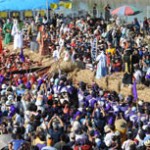
August 1, Ryukyu Shimpo
The Yonabaru Great Tug-of-War, one of Okinawa’s three largest tug-of-war events, has a history going back more than 400 years in the prefecture. This year’s event, in which the east side of the town pulled against the west side, was held at the Udun-yama Youth Square in Yonabaru Town on July 31.
The rope weighed about 4500 kilograms and was about 80 meters long, ten meters shorter than usual because of the lack of straw due to Typhoon No.2.
The two teams pulled as hard as they could against each other.
According to the event organizer, about 15000 visitors from both within and outside the town enjoyed a grandstand finish.
Both sides had their own shitaku – a costumed person who stands on the rope – as they made their way to the square. This year the shitaku of the east side was dressed as oyake akahachi, a Ryukyuan local chief (aji) of Ishigaki Island who rebelled against the Okinawan authorities in 1500 and that of the west side wore the costume of Ozato aji, a ruler of the Ozato area back in the days of the Ryukyu Dynasty.
When both sides arrived at the square, the members of chinamushi, or rope carriers, who were worked up ready to go in the tug-of-war, and members of the public who also took part in the event, gave a morale-boosting rally call of “Ei, Ei, Oh!”
Both sides started pulling against each other after the two sections of the gigantic rope (the male rope for the east side and the female rope for the west side) were linked by means of a three-meter wooden pole called a kanachi bar, immediately throwing up a cloud of dust.
When the west side pulled the east side towards them, gaining a slight advantage, the east side did its best to pull back. All of a sudden the male side of the rope on the east broke, automatically giving victory to the west side. The intense contest lasted a total of two minutes and 20 seconds.
It has been 30 years since the last time the rope broke. Fifty-year-old Tadashi Uehara, an adviser for the east side, said ruefully, “We made a good quality rope, but the number of participants has more than doubled in comparison with previous years, and they were so committed to the contest that the strain on the rope was just too much for it bear.”
Every year, commemorative T-shirts are created for the tug-of-war events.
This year, to support people in the areas stricken by the Great East Japan Earthquake, the organizers of the event added the message, “Link the feelings of those people in the afflicted areas with ours, Chibariyo (Stick to it!), eastern Japan!”
Part of the profit from the event will be donated to the areas affected by the earthquake and tsunami.
(English Translation by T&CT, Mark Ealey)
Go To Japanese

Go To Video
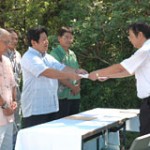
August 1, 2011 Ryukyu Shimpo
The United States military returned the Gimbaru Training Area to Kin Town and other owners, on July 31, 54 years after the land was appropriated for military use. Twenty-three hectares of a total area of 60 hectares were handed over to the owners. Thirty-three hectares will be returned to the landowners after the completion of works including the removal of buildings and researching and analyzing the environment for residual pollution using the likes of a magnetic survey. Four hectares of state-owned land and ridou, or old public road without lot-numbers, will be transferred to the Town. A total of 43 individuals and organizations, including Kin Town, own land inside the Ginbaru Training Area. Because the government will not pay a rental fee for the land, special financial compensation will be paid to the landowners for up to three years from August 1, the day that the land is returned.
The return of the Ginbaru Training Area was agreed upon by the governments of the United States and Japan in the final report of the Special Action Committee (SACO) in 1996. However, there was a delay in the return process because it was decided that the helipad in Ginbaru should be moved to the Blue Beach Training Area in the same town, and so the return of the Training Area was significantly delayed beyond the scheduled date of the end of 1997. The Training Area is the fifth facility that the final report of SACO agreement decided should be returned.
Kin Town plans to attract medical rehabilitation facilities and hotels to the vacant lot previously used by the now closed military installation. Tsuyoshi Gibu, head of Kin Town who went into the training area on July 31, said, “I feel quite emotional about this. We want to develop it as a model for the consolidation and reduction of U.S. bases. We will ask the government to help us to succeed in converting the military facilities to civil use.”
Inside the training area there are still three buildings of a fire-fighting facility, a silt removal facility and the hangars used to house nuclear-warhead capable Mace B cruise missiles. Gibu said, “We want the government to restore the site to its original state. We will then take a good look at it and check what the situation is in the area.”
Meanwhile, the U.S. military has often carried out helicopter landing drills outside the helipad in the Blue Beach Training Area, despite the government having promised that the helicopter landing drills will fundamentally be held at the helipad. Town officials have protested to the U.S. military, and requested that they hold the drills at the helipad within the Blue Beach Training Area.
(English Translation by T&CT, Mark Ealey)
Go To Japanese
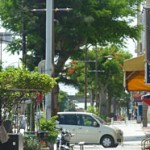
July 29, 2011 Ryota Shimabukuro of the Ryukyu Shimpo
With the yen’s recent sharp appreciation against the U.S. dollar due to the United States debt ceiling crisis, Okinawa City, which plays host to U.S. military bases, is experiencing a downturn in consumer spending by U.S. military and civilian personnel, who do most of their shopping in dollars.
During the past ten years, the Prefecture has observed sluggish movement in currency exchange from dollars to yen. The yen has been appreciating from 120-130s to around 80 against the dollar.
Some people in Okinawa City suggest that the city should mull over these developments calmly before making some fundamental changes.
There are shops with English language signs in Koza Gate Street, which leads to Kadena Air Base, but fewer U.S. military personnel are seen shopping in the area these days.
The chairman of the Koza Gate Street Association, Seiei Gakiya, an eyewear shop owner, pointed out that United States debt ceiling crisis has dampened the consumer appetite of U.S. military personnel, saying “Although the U.S. dollar has been a universal currency for quite some time, America’s monetary problems are being reported all over the world, making U.S. military personnel in Okinawa more budget-minded.”
Gakiya said, “The Association cannot do anything to reverse trends in the world economy, but we would like the prefectural government and Okinawa Chamber of Commerce and Industry to urgently think of ways to deal with the yen appreciation.”
But at the same time, Gakiya said, “The yen has been appreciating for a long time. While 80% of our customers used to be U.S. military personnel, those numbers have been steadily decreasing. It is possible that they are shopping inside the bases or even go to other municipalities, which could explain the decrease.”
Gakiya continued, “We need to take drastic measures to find a way out of this situation.”
It is reported that currency conversion from the yen to the dollar started to rapidly show a declining trend at the Lucky Exchange Center, located in Koza Music Town, when the yen began rising above 80 yen against the dollar.
The staff of the center said, “U.S. military personnel tend to convert the minimum amount of dollars to yen for their essential expenses.”
Some U.S. military personnel or retired military personnel are reported to have complained after seeing the amount of cash they get in a dollar-yen conversion, saying “This place used to be a paradise, but now I’d like to go back to the United States.”
Micky, the family restaurant in Koza’s Central Park Avenue, has been operating at the exchange rate of 100 yen per dollar despite the appreciation of the yen. While the cost of ingredients has been rising during these times of business difficulties, the yen’s appreciation further serves to aggravate the situation. Although you can still purchase a five dollar set-menu for 500 yen, its sales takings amount to only 400 yen when converted at the current exchange rate. Eriko Kadena, the owner of the restaurant said, “The sales point of our restaurant has been that you can eat a hearty set menu for one 500-yen coin. But there is a limit to how far we can reduce the amount of ingredients to avoid price increases.”
(English Translation by T&CT, Mark Ealey)
Go To Japanese
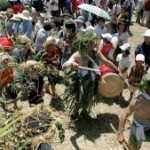
August 1, 2011 Ryukyu Shimpo
Shinugu, which is designated as a significant intangible folk cultural asset of Japan, was carried out in Ada, Kunigami Village on July 31.
Including rituals such as yamanubui, in which men crowned with grassy headwear and covered with leaves go into the jungle to undergo a purification ceremony, and ushindeku, in which only women do the dancing, the participants prayed for a good crop and perfect health in their region. The village was abuzz with many people both from within the region and from outside.
The yamanubui started around noon with the men climbing up a mountain from three different locations before expressing their appreciation to the god of the mountain and the god of the sea, and then praying for a rich harvest. They chanted “E-he-ho-i (yo-ho)” as they climbed down the mountain, carrying out a purification ceremony as they went.
They then made their way through the village from where they marched to the beach, where once again they prayed to the god of the mountain and the god of the sea.
In the evening, the participants prayed for a year of good harvests, performing various dances such as the yahariko, in which they perform the actions of a ship launching ceremony, the tankusatoyou, in which the participants mimic the motion of pulling up weeds, and ushindeku.
For shinugu, two different types of festival are carried out in alternate years. This year was the ufushinugu, the bigger festival, and next year will be the shinugungua, the smaller version.
(English Translation by T&CT, Mark Ealey)
Go To Japanese

Go To Video















 Webcam(Kokusai Street)
Webcam(Kokusai Street)


